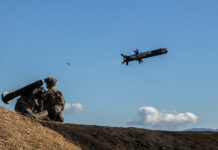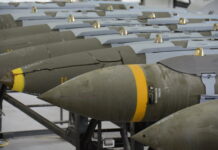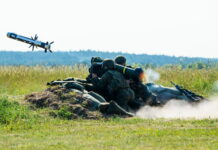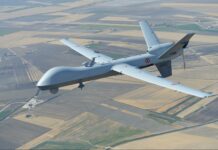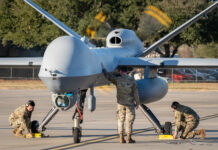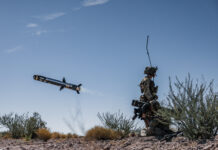Tactical precision strike, or recce-strike as it is occasionally known, has exploded as an area of concern for forces around the globe. This article explores the design parameters and requirements that make for an effective strike system, and what it is that is driving militaries to seek them out.
In July 2009, General Stanley McChrystal, the Director of US and ISAF forces in Afghanistan issued a new tactical directive to the soldiers serving in Afghanistan. It required them to preserve civilian life during contacts and issued new guidance for the use of close air support and indirect fires.[1] By January the following year, the British Army’s use of high explosive (HE) artillery rounds had fallen 60%, its use of smoke increased by 70%.[2] The directive became known as courageous restraint, it required soldiers to exercise restraint in the use and escalation of force when engaged, especially when civilians were present. At the same time, the Taliban’s tactics were growing in complexity. Improvised explosive devices (IEDs) were connected and used in tandem with long-range direct fire engagements. The latter were often suppressive, but conducted beyond the reach of a typical section’s direct firepower, courageous restraint restricted the use of section mortars. The Taliban exploited this, and conducted engagements in urban environments that maximised its advantages.
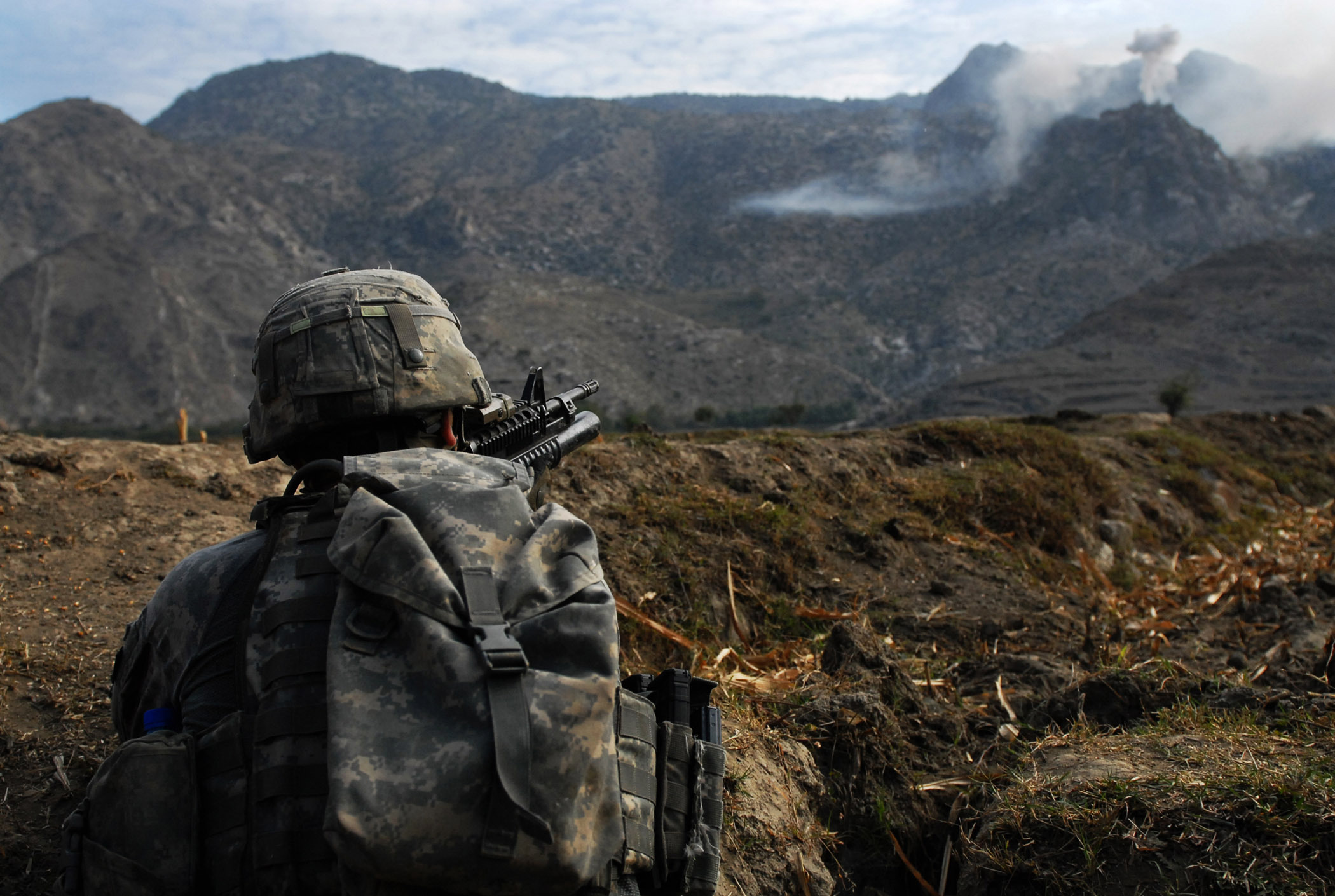
Credit: US Army/Sgt Matthew Moeller
Conventional air and indirect firepower were unsuitable assets in those scenarios, as the damage – even with precision guidance – was too indiscriminate. Infantry sections could use FGM-148 Javelin guided missiles in some situations, and in others, MQ-9 Reaper uncrewed aerial vehicles (UAVs) patrolling overhead could provide accurate strikes with AGM-114 Hellfire missiles.[3] However, MQ-9s were, and still are, a brigade- or taskforce-level asset. This means that section commanders would have to bid on them and hope that there were sufficient MQ-9 orbits to meet their needs. Fast forward to 2023 and the frontline in Ukraine; calls for conventional fire support from artillery and close air support on the Russian side, are sent hundreds of times a day. The resultant firepower has desolated every town it has come into contact with, and millions of artillery rounds have been expended. However, many infantry sections on the frontline are able to answer their own needs for fire support with the help of drones.
Small drones provide reconnaissance at a section level, 1-10 km from where the section is, and there is no need for many units to request that support, as they own the drones. Larger types with greater range still sit at operational levels, conducting reconnaissance at depths of 50 km or more behind the front, but at short ranges, aerial reconnaissance has been democratised and made accessible to all.
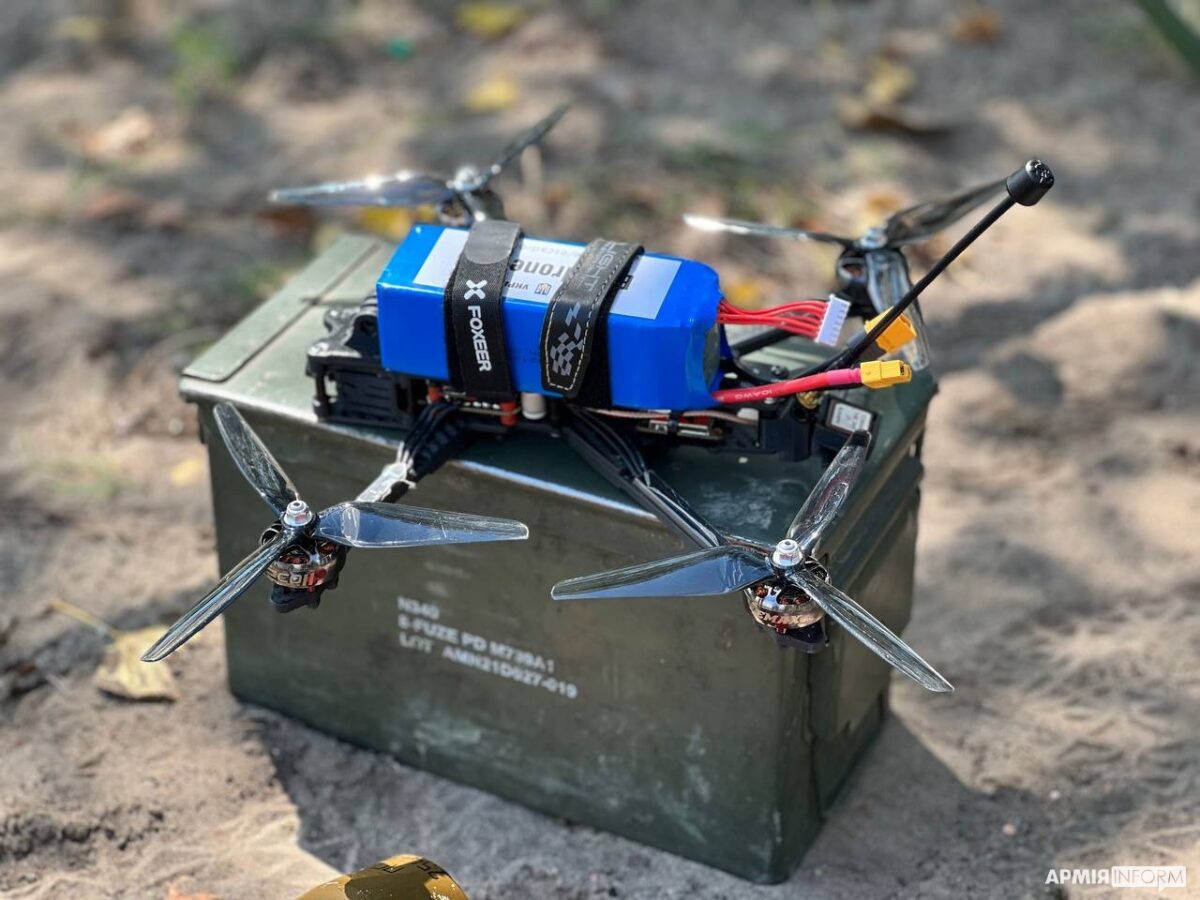
Credit: АрміяInform, via Wikimedia Commons
With the spread of small drone technology, militaries around the world are now capable of deploying tactical reconnaissance-strike systems. A system that includes the means of reconnaissance and effect in a single platform, enabling it to conduct reconnaissance and strikes in real time. “We think of it as tactical or organic precision fires designed to deliver precision strikes into the hands of the close combat operator”, Mick Aston, director of global defence at Overwatch, a British defence technology company that is focused on uncrewed systems and their payloads, told ESD.
Drone technology has consistently fallen in price since McChrystal issued his directive in 2009, and has played a prominent role in most conflicts since. Ukrainian units and Russian forces fighting in Ukraine since 2015 have used drone-delivered munitions to strike at each other in the absence of heavy artillery.[4] ISIS were able to use massed drone strikes to degrade and disrupt Iraqi formations in Mosul in 2017, or they were employed to provide situational awareness for ISIS commanders during company-level assaults.[5] In Syria, government forces have accelerated their use of first person view (FPV) drones to target civilians and opposition fighters since early 2024.[6] The reasons and enablers for the growth of these systems are relatively clear; the reduction in cost of the components and the increased ease with which they can be used has enabled any force with sufficient motivation to adopt some form of tactical precision strike capability. The drivers are a mixture of a lack of precision munitions, as well as greater battlefield dispersion and smaller forces that necessitate greater quantities of ISR. “Battalion-sized formations are now able to occupy a battlespace that would normally be fought over by a brigade, all because of sensors and precision strike,” Aston explained.
Design for success
The FPV paradigm is largely defined by home-made systems; they are built either using existing FPV racing drones or by procuring parts from China and then assembled with a pre-existing munition such as a PG-7V grenade. They are purpose-built in the sense that they do not exist in that format on the open market, but they are not designed for the role of tactical precision strike. They are designed to have enough thrust to take-off with the munition and fly quickly to a target. When configured as a quadcopter, the four electric motors generate a loud noise, which impacts their use as acoustic detection is the primary means of locating them. They are used against moving vehicles or when there is a lot of noise on the battlefield, so that the sound of the engine or other combat noises can mask the sound of the approaching drone. They are also quite straightforward in their control link design, which means that jamming can be effective against them. In short, the FPVs and frontline-developed drones are not designed for military use in the sense that they are not optimised for the role they perform.

Credit: USMC/Cpl Austin Gillam
A number of factors must be considered to optimise the design of a tactical precision strike drone. Ideally, the customer would provide a clear concept for how the system will be employed on the battlefield. Then, the designer would have to consider the following:
- Portability: For tactical systems the limit is always the human ability to carry the drone. Infantry can expect to carry 68 kg of equipment into combat, or more if they are operating away from a base for a long time.[7] This is not a hard and fast rule, but shapes everything else that the strike system can be.
- Launch requirements: A tactical system will, by necessity, be operated from challenging terrain. This might be a treeline or bunker as is common in Ukraine, from within the depths of a city, or from inside an armoured vehicle. The launch requirements are also shaped by the configuration of the drone; for instance, a fixed wing design requires some form of initial thrust imparted by either throwing it (if small, such as the RQ-20B Puma used by the USMC) or a tube-based launch mechanism (such as the Switchblade 300).[8] A rotary-wing design may have fewer launch requirements, but should be able to fly through tree cover or navigate tall buildings and cables immediately upon launch.
- Range: Tactical precision strike capabilities are defined by the section’s battlespace. This could be considered as ‘the fight in front of the section’, as opposed to anything beyond that. This creates an effective maximum range requirement of 10-20 km.
- Lethality: The threats and targets an infantry section might have to engage will vary in complexity and survivability from an opposing section in the open or a building, to a main battle tank, or an enemy command unit.
- Weight: The weight of the system is impacted by the portability requirements as well as the range and lethality. These aspects need to be balanced; it must not be too heavy to carry or impact its range, but it must also carry enough lethality to address the full spectrum of targets that a section might encounter.
- Thrust: The thrust-to-weight ratio refers to the amount of thrust that the system’s propulsion must provide to generate the optimum performance. It considers the weight and range requirements, and can shape propeller configuration and launch requirements.
- Control and navigation: Tactical precision strike assets must be easy to control and resistant against enemy jamming.
The design of Pholos, the tactical precision strike system developed by Overwatch, began with a potential customer’s concept of operations, Aston explained. “Design considerations come down to the most effective way of gaining max take-off weight vs thrust,” Jeff Keene, CTO for the aerospace sector at Overwatch added. “Some quadcopters tend to have high RPMs [revolutions per minute] and smaller rotors, but this makes them very audible, and the signature carries a long way,” Keene said. The Pholos uses two coaxial contra-rotating two-blade propellers, which creates a much smaller system footprint but provides the same take-off thrust as a quadcopter. “The Pholos employs a coaxial rotor system to provide a larger disc area in a smaller footprint than a standard quad [copter] with the same lift capacity. This in turn allows for a lower RPM helping to reduce the acoustic signature”, Keene explained.

Credit: Overwatch
Pholos is interesting because it has been built and optimised for the role of tactical precision strike – it is not an existing drone design paired with an existing munition. Overwatch also provides the lethality component, which is designed to be selected by the section before launching Pholos. As the lethal payload is not an integrated part of the design, it can be swapped between shaped charges and HE. More importantly, it means the warhead can be designed specifically for the conditions encountered by a drone. A mortar bomb or PG-7V grenade must withstand considerable launch and impact forces that are not present in the flight of a drone. This means that they are not optimised for the tactical precision strike use-case and may be excessively heavy or insufficiently lethal for their intended target or use.
Pholos can carry a 2 kg lethal payload with an endurance of 25 minutes and a total system weight of 6.5 kg, it can also be returned to the user if no strike is conducted.[9] For comparison, the Switchblade 300 Block 20 from AeroVironment performs a similar role, with a range of 30 km using an extended range antenna, and allows the user to select the terminal attack angle. Switchblade is a tube-launched fixed-wing design; the loitering munition by itself weighs 1.68 kg, and when combined with the launch tube, has an all-up round weight of 3.3 kg.[10] Examining some of the differences between Pholos and Switchblade demonstrates how the use case and design considerations impact system performance.
Design comparisons
The Switchblade 300 and Pholos can both be used to provide a section or platoon with an organic immediate, real time strike capability. However, they represent different approaches in development and design. The Switchblade 300 has folding wings and is launched from a tube, this means that it must fly constantly or risk stalling if its speed is not maintained. It can still loiter over a target area by flying a pattern, but cannot statically hover in place.

Credit: AeroVironment
Pholos, on the other hand, employs a coaxial rotor configuration that means it can be launched vertically from the ground through tree cover or in an urban environment with tall buildings. Its rotors allow it to maintain a position over a given point for reconnaissance or to spend more time on target identification. Pholos can carry a higher payload, and also change its warhead to suit the target. Without an interchangeable warhead, Switchblade 300 must use its built-in warhead, stated by the manufacturer as providing “Anti-personnel effects”, which means it will not be suited to engaging every target type it might encounter.[11] Here it should be noted that AeroVironment does offer the larger Switchblade 600 for combating armour, equipped with a high explosive anti-tank (HEAT) warhead similar to that used on the Javelin ATGM, however this model is significantly heavier than the Switchblade 300, with the loitering munition by itself weighing 15 kg, and an all-up round weight of 29.5 kg.[12]
Both Switchblade 300 and Pholos are designed to be carried by infantry in addition to their standard combat load. The Switchblade 300 all-up round weight is nearly half that of the Pholos, however the latter can be separated from its 2 kg payload, allowing one soldier to carry the warhead and another to carry the drone. User requirements would decide whether or not it is more important to have an overall lighter system, or a more lethal one. Another design element to consider is speed. Switchblade 300 has a loiter speed of 101 km/h, which allows it to engage targets fairly rapidly, however, this also affects its ability to turn and the way in which it interacts with obstacles. For instance, it may not be possible to fly extremely close to or within a treeline. By contrast, while Pholos is slower, it is able to fly tactical routes around landmarks or obstacles and make greater use of terrain to conceal its movements. Again, the way in which tactical precision strike assets are designed usually dictates how they are ultimately used. Designers try to accommodate the user, but combat produces unusual and challenging situations that are hard to replicate. Overwatch believes a layered approach is necessary, with a mixture of fixed- and rotary-wing assets available at the tactical level and through to the battlegroup or taskforce.
This appears to be the approach pursued by Russian forces, which employ a lot of frontline FPVs, combined with larger fixed-wing reconnaissance drones at the battalion level, and fixed-wing loitering munitions such as Lancet for deep strikes from 40-70 km behind the frontline. However, the key for western forces will be employing loitering munitions at sufficient scale and at the right echelon within a force. Systems such as Pholos and Switchblade 300 need to be considered as missiles, rather than aircraft, and deployed as if they were an addition to the infantry section’s arsenal, rather than a special type of system held only within certain units. These changes will undoubtedly come, but they reflect the change in mindset and training that is necessary.
In sum
“We built Pholos because of our experience in Afghanistan,” Mark Melhorn, head of business development at Overwatch and a former rifleman in the British Army, told ESD. “During courageous restraint, we would often be suppressed and unable to return fire effectively. The enemy was disbursed, which meant that even if we could use conventional fires, it was difficult to achieve any effect without the appropriate precision.”
In many ways, the need for tactical precision strike has always existed, and while its development in Ukraine has been organic, it resulted in many ways from a lack of precision and non-precision fires. It is not a thought-through and rigorous development of existing capabilities within an armed force, but a workable solution to a desperate situation. Western forces are not approaching tactical precision strike from the same direction; they have the relative luxury of time to observe and develop systems that complement their force structures, and that will deliver added capability to make their infantry formations more lethal and survivable in any war. It is important to bear this in mind as the tactical precision strike technology sector evolves and develops. The above design considerations may help to provide a baseline for assessing that sector in the process, and discerning what requirements it is trying to meet.
Sam Cranny-Evans
[1] https://www.amacad.org/sites/default/files/publication/downloads/Daedalus_Wi17_04_Felter-Shapiro.pdf
[2] http://news.bbc.co.uk/1/hi/uk/8484205.stm
[3] https://mwi.westpoint.edu/podcast-the-spear-the-reaper-in-combat/
[4] https://www.defenseone.com/technology/2017/11/ukraine-fields-armed-drone-use-against-russia/142651/
[5] https://edinburghuniversitypress.com/book-how-isis-fights.html
[6] https://www.aljazeera.com/news/2024/2/27/the-syrian-regime-is-stepping-up-its-use-of-suicide-drones
[7] https://foreignpolicy.com/2016/10/27/colonel-the-infantry-officer-course-standard-actually-does-apply-to-combat/; https://mwi.westpoint.edu/the-overweight-infantryman/
[8] https://www.avinc.com/lms/switchblade
[9] https://www.overwatch-group.uk/aerospace/pholos/
[10] https://www.avinc.com/images/uploads/product_docs/Switchblade_300_Block20_Datasheet.pdf
[11] https://www.avinc.com/images/uploads/product_docs/Switchblade_300_Block20_Datasheet.pdf
[12] https://www.avinc.com/images/uploads/product_docs/Switchblade600_Datasheet.pdf


